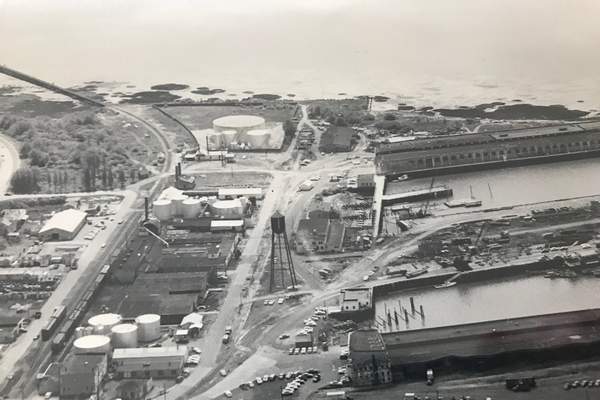forum
library
tutorial
contact

Decision Nears on Port of Astoria
Oil Contamination Cleanup
by Edward Stratton
Daily Astorian, February 28, 2018
|
the film forum library tutorial contact |

|
Decision Nears on Port of Astoria
by Edward Stratton
|
Since the early 1900s, much of the central waterfront was occupied by large oil storage and distribution facilities
 The state Department of Environmental Quality is nearing a decision on the best method to clean up the historical petroleum contamination at the Port of Astoria's central waterfront.
The state Department of Environmental Quality is nearing a decision on the best method to clean up the historical petroleum contamination at the Port of Astoria's central waterfront.
Anna Coates, a natural resources specialist with the state, said the department will meet with the Port to get feedback and likely make a decision in the coming weeks.
Since the early 1900s, much of the central waterfront was occupied by large oil storage and distribution facilities, including pipes and storage tanks above and below ground. The heaviest stretch of pollution runs beneath a commercial complex at the corner of Gateway and Hamburg avenues -- the site of a former bulk oil plant run by Mobil and Ed Niemi Oil companies -- and under the former Port offices, ending at the southeastern base of a slip between piers 2 and 3.
In the late 1990s, a pipe leaked and created a sheen in the Columbia River, Coates said. In 2001, the state initiated negotiations with the Port, Niemi Oil, Harris Industries and McCall Oil & Chemical Corp. on an investigation of the pollution and feasibility study for cleanup.
The investigation identified the main source of petroleum from a former ExxonMobil/Niemi Oil bulk plant, a documented diesel release from a McCall pipeline, an underground storage tank previously operated by the Port and other nearby pipelines.
Over the years, contaminants have been pumped out, pipelines decommissioned, underground storage tanks removed and the Port's stormwater system rerouted to avoid the main areas of pollution. Booms were placed at the base of Pier 1 to catch hydrocarbons leaching into the river. The measures have led to a general decrease of petroleum in the groundwater.
Several potential solutions have been presented to address the main area of pollution.
The Department of Environmental Quality initially proposed venting contamination out of the ground, removing surface soils and capping the area of pollution with a permeable layer of sand, gravel and Organoclay to leach out contaminants in the slip. The project was estimated to cost nearly $4 million.
The Port challenged the cleanup option and proposed an asphalt dock and sheet pile wall to better withstand winter weather in Astoria. The project was estimated at $6.5 million.
The state hired Hart Crowser, an environmental consulting firm, to compare cleanup options.
Hart Crowser found the Port's proposal excessive and unsuitable for withstanding earthquakes. The consultant ultimately recommended a series of marine mattresses composed of fill material in a high-strength fabric to be laid along the slip. The mattresses would be covered with rock riprap to further protect against weather and waves. The entire project is estimated at nearly $3.2 million.
The Port's dilemma is another reminder of the risk from Astoria's industrial past.
A recent oil spill from an underground tank used to fire the boilers of historical canneries soiled the river near the Cannery Pier Hotel. The owner of Astoria Marine Construction Co., meanwhile, has said a costly, state-mandated cleanup will likely close his shipyard.
Coates has overseen other cleanup projects along the Astoria waterfront from former fuel operations, including a former manufactured gas plant and bulk fuel facility between Second and Third streets near the Columbia House Condominiums, and a former Chevron bulk petroleum plant near the Wilcox & Flegel Oil Co. fuel dock.
"They have to be protective," Coates said of the cleanup projects. "They have to meet all the standards. There's an objective ranking."
The marine mattress was "the most sustainable alternative with minimal construction activity, no treated water disposal requirements and does not impact Port operations," Hart Crowser wrote.
Once the state makes a decision, the public can weigh in on the cleanup plan, Coates said. A record of decision is issued, followed by design and construction.
"It's up to them how they want to negotiate payment," Coates said of the Port and the oil companies.
learn more on topics covered in the film
see the video
read the script
learn the songs
discussion forum
